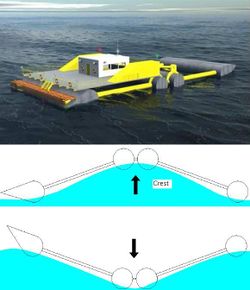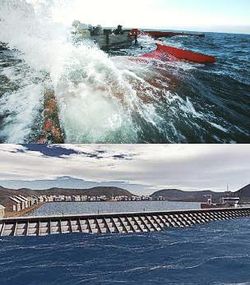Difference between revisions of "Wave energy converters"
| Line 19: | Line 19: | ||
===Overtopping Devices=== | ===Overtopping Devices=== | ||
| − | [[Image:OVTs examples.jpg|thumb|right|250px|Figure 3: Different overtopping devices]]Another type of Wave energy converter is the overtopping device, which works much like a hydroelectric dam. The Wave Dragon created by Wave Dragon ApS<ref>Wave Dragon Aps [http://www.wavedragon.net/ Wave Dragon website]</ref> is an example of an offshore overtopping device (Fig. 3). Its floating arms focus waves onto a slope from which the wave overtops into a reservoir. The resulting difference in water elevation between the reservoir and the mean sea level then drives low-head hydro turbines. Proposed optimal size design of 260m width and 150m length will produce 4 MW. In wave climates above 33 kW/m, this technology is expected to be economically competitive with offshore wind power in the near future. After a combined cost saving and power efficiency increase, the power price will eventually be in line with costs of fossil fuel generation (Christensen et al., 2005<ref>Christensen, L., Friis-Madsen, E., Kofoed, J.P., 2005. The Wave Energy Challenge: The Wave Dragon case. ''PowerGen 2005 Europe Conference - Wave Dragon'', 20pp. [http://www.wavedragon.net/index.php?option=com_docman&task=doc_download&gid=1&Itemid=28]</ref>). | + | [[Image:OVTs examples.jpg|thumb|right|250px|Figure 3: Different overtopping devices]]Another type of Wave energy converter is the overtopping device, which works much like a hydroelectric dam. The Wave Dragon created by Wave Dragon ApS<ref>Wave Dragon Aps [http://www.wavedragon.net/ Wave Dragon website]</ref> is an example of an offshore overtopping device (Fig. 3). Its floating arms focus waves onto a slope from which the wave overtops into a reservoir. The resulting difference in water elevation between the reservoir and the mean sea level then drives low-head hydro turbines. Proposed optimal size design of 260m width and 150m length will produce 4 MW. In wave climates above 33 kW/m, this technology is expected to be economically competitive with offshore wind power in the near future. After a combined cost saving and power efficiency increase, the power price will eventually be in line with costs of fossil fuel generation (Christensen et al., 2005<ref>Christensen, L., Friis-Madsen, E., Kofoed, J.P., 2005. The Wave Energy Challenge: The Wave Dragon case. ''PowerGen 2005 Europe Conference - Wave Dragon'', 20pp. [http://www.wavedragon.net/index.php?option=com_docman&task=doc_download&gid=1&Itemid=28]</ref>). <br/> |
| + | Onshore, OVTs can be installed in front of or as part of caisson breakwaters. The Norwegian company WAVEnergy is developing an integrated multi level overtopping device named the SeaWave Slot-Cone Generator (SSG). '''INCOMPLETE''' | ||
===Point absorbers, Terminators and Attenuators=== | ===Point absorbers, Terminators and Attenuators=== | ||
Revision as of 09:36, 12 July 2011

|
Contents
Introduction
Vast and reliable, wave power has long been considered as one of the most promising renewable energy sources. Wave Energy Converters (WECs) convert wave power into electricity. Although attempts to utilize this resource date back to at least 1890, wave power is currently not widely employed (Miller, 2004[1]). The plethora of innovational ideas for wave power conversion have been invented in the last three decades, resulting in thousands of patents over recent years. At present, a number of different wave energy concepts are being investigated by companies and academic research groups around the world. Although many working designs have been developed and tested through modelling and wave tank-tests, only a few concepts have progressed to sea testing. Rapidly decreasing costs however, should enable wave plants to compete favorably with conventional power plants in the near future (Pelc and Fujita, 2002[2]).
Classifications
Wave Activated Bodies
Wave activated bodies (WABs) are devices with moving elements that are directly activated by the cyclic oscillation of the waves. Power is extracted by converting the kinetic energy of these displacing parts into electric current. One example of such a WAB, is made by a single floater connected to a linear magnetic generator fixed to the seafloor. In other cases, only parts of the body are fully immersed and dragged by the orbital movements of the water. In order to maximally exploit this resource, the moving compounds need to be small in comparison to the wave length and preferably they are placed half a wavelength apart. For these reasons, wave activated bodies are usually very compact and light. The main disadvantage of this type of wave energy converters is the high cost of the power generator needed to convert the irregular oscillatory flux into electricity.
The "DEXA", developed and patented by DEXA Wave Energy ApS [3], is an illustrative example of a WAB. The device consists of two hinged catamarans that pivot relative to the other (Fig. 1). The resulting oscillatory flux at the hinge, is harnessed by means of a water-based low pressure power transmission that restrains angular oscillations. Flux generation is optimized by placing the floaters of each catamaran half a wavelength apart. A scaled prototype (dimensions 44x16.2m[4]). placed in the Danish part of the North Sea should generate 160 kW (Martinelli et al., 2009[5]). Full-scale models are thought to be able to generate up to 250 kW. [3]
Oscillating Water Columns
The function of the oscillating water columns (OWCs) is very similar to that of a wind turbine, being based on the principle of wave induced air pressurization. The device is set upon a closed air chamber, which is placed above the water. The passage of waves changes the water level within the closed housing and the rising and falling water level increases and decreases the air pressure within the housing - introducing a bidirectional air flow. By placing a turbine on top of this chamber air will pass in and out of it with the changing air pressure levels. There are two options to separate the bi-directional flow: a Wells turbine to create suction or alternatively, pressure generating valves (Kofoed and Frigaard, 2008[6]). OWC devices can be moored offshore or be placed on the shoreline where waves break.
An example of an offshore OWC is the "Sperboy", developed and patented by Embley Energy LTD [7]. It is circular in plane and therefore invariant to wave direction (Fig. 2). Its size varies according to the target sea conditions at the deployment site but maximum dimensions are set at 30m diameter, 50m height and 35m draft. Up to 450 kW mean annual output can be obtained from this concept. An inshore example is the resonant wave energy converter REWEC-3, created by the Università degli Studi "Mediterranea" di Reggio Calabria (Fig. 2). It operates much like conventional concrete caisson breakwaters but here, each caisson is fitted with a Wells turbine. Efficiency of these devices is generally considered to be high (Boccotti, 2003[8][9]).
Overtopping Devices
Another type of Wave energy converter is the overtopping device, which works much like a hydroelectric dam. The Wave Dragon created by Wave Dragon ApS[10] is an example of an offshore overtopping device (Fig. 3). Its floating arms focus waves onto a slope from which the wave overtops into a reservoir. The resulting difference in water elevation between the reservoir and the mean sea level then drives low-head hydro turbines. Proposed optimal size design of 260m width and 150m length will produce 4 MW. In wave climates above 33 kW/m, this technology is expected to be economically competitive with offshore wind power in the near future. After a combined cost saving and power efficiency increase, the power price will eventually be in line with costs of fossil fuel generation (Christensen et al., 2005[11]).Onshore, OVTs can be installed in front of or as part of caisson breakwaters. The Norwegian company WAVEnergy is developing an integrated multi level overtopping device named the SeaWave Slot-Cone Generator (SSG). INCOMPLETE
Point absorbers, Terminators and Attenuators
Mooring
Wave energy converters as a coastal defense technique
See also
References
- ↑ Miller, C.,2004. A Brief History of Wave and Tidal Energy Experiments in San Francisco and Santa Cruz. [1]
- ↑ Pelc, R. and Fujita, R.M., 2002. Renewable energy from the ocean. Marine Policy, 26,471-479.
- ↑ 3.0 3.1 Dexawave Energy ApS. Dexawave website
- ↑ Kofoed, J.P., 2009. Hydraulic evaluation of the DEXA wave energy converter. DCE Technical Report No. 57. Dep. of Civil Eng., Aalborg University, 23 pp.
- ↑ Martinelli L., Zanuttigh,B., Kofoed, J.P., 2009. Statistical analysis of power production from OWC type wave energy converters. EWTEC Conference, Uppsala, 7-11 Sept 2009, electronic format, 9 pp.
- ↑ Kofoed, J.P. and Frigaard, P., 2008. Hydraulic evaluation of the LEANCON wave energy converter. DCE Technical Report No. 45. Dep. of Civil Eng., Aalborg University, Oct. 2008. Leancon Wave Energy. Leancon website
- ↑ Embley Energy LTD Sperboy tm website
- ↑ Boccotti, P., 2003. On a new wave energy absorber. Ocean Engineering, 30, 1191–1200.
- ↑ Ricerca Italiana Ricerca Italiana on REWEC-3
- ↑ Wave Dragon Aps Wave Dragon website
- ↑ Christensen, L., Friis-Madsen, E., Kofoed, J.P., 2005. The Wave Energy Challenge: The Wave Dragon case. PowerGen 2005 Europe Conference - Wave Dragon, 20pp. [2]
Please note that others may also have edited the contents of this article.
|


